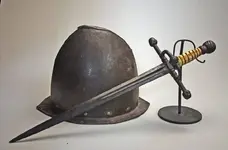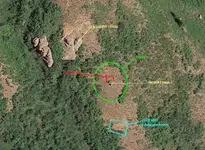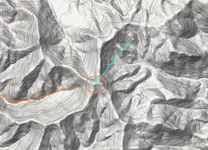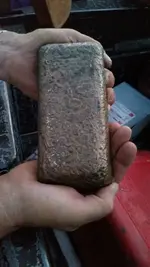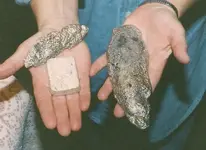I'm not saying this was me at all :-)
PAGE, Ariz. – Is it a remarkable discovery or a clever hoax?
A hiker in southern Utah has found what appear to be old Spanish coins possibly dating back to the time of the conquistadors and perhaps even earlier, long before the voyages of Columbus.
The big question the National Park Service is trying to answer is: If they’re real, what are they doing in southern Utah?
"This is very exciting," said park service archaeologist Brian Harmon. "I’ve never seen anything like this in my career."
The mystery began last September when a hiker from Colorado made the discovery near the Halls Crossing Marina on Lake Powell. Park officials are keeping the exact location secret because of the possibility there are other undiscovered artifacts in the area. They’ve been keeping the two coins under wraps, too – deliberately not publicizing the find – because they aren’t sure yet what to make of it.
When KSL learned about the coins, though, Harmon confirmed the find and showed off the coins. They’re being kept in Page, Arizona, in the archives of the Glen Canyon National Recreation Area. Museum technician Lisa Riedel carefully unwrapped them while wearing white gloves.
“Well, we’re just trying to not touch them and (not) get oil from hands or whatever else, dirt on them," Riedel explained. “For being in the elements, they look really well-preserved.”
These coins, which appear to be old Spanish coins dating back to the time of the conquistadors and perhaps even earlier, were allegedly found by a hiker near the Halls Crossing Marina on Lake Powell in September 2018. The National Park Service is trying to authenticate the coins and determine how they made it to that location. (Photo: John Hollenhorst, KSL TV)
The two small coins – one about the size of a quarter and the other smaller than a dime – definitely give the appearance of being ancient. They don’t appear to be gold; they are slightly greenish in color, suggesting the presence of copper.
"They're very thin," Riedel said. "We're guessing one is probably silver and one is maybe copper."
According to Harmon, the coins were found in a popular tourist area that has at times been underwater in the decades after the Glen Canyon Dam was built in the 1960s. The Colorado hiker, whose identity is being kept confidential, told the park service that he spotted the coins just lying on the ground. He was not using a metal detector; their use is illegal in national recreation areas and other lands administered by the National Park Service.
“There was a lot of trash around," Harmon said. "He thought they (the coins) were maybe medallions from a wine bottle or something. So, modern trash. He picked them up, took them home. When he started looking at them, he’s like, 'Hey, these might actually be something, very old and very important.' He did a bit of research on his own on the internet and figured out that they were old Spanish coins."
The Colorado man’s research brought him to a startling conclusion. He told the park service that he believes the larger one matches coins from the 1660s and the smaller one matches coins from the 1290s, two full centuries before Columbus. With that realization, he decided to turn them over to the park service.
"His behavior was a model of how to respect the history," Harmon said. "You know, he picked these up thinking they were modern trash. It was an honest mistake. And as soon as he realized what he had, he reached out to us."
So what we're doing is reaching out to experts in old Spanish coins to learn, are these authentic? How old are they?—Brian Harmon, Utah State Parks
The park service so far has not confirmed the discoverer’s conclusions.
"So what we're doing," Harmon said, "is reaching out to experts in old Spanish coins to learn, are these authentic? How old are they?"
If they are authentic, that would deepen the mystery: It’s a real puzzler to contemplate how old Spanish coins got to Utah and how they fit into the known history of European exploration. The first well-documented Spanish expedition into the area was in 1776 led by two Spanish priests, Father Atanasio Dominguez and Father Silvestre Velez de Escalante. But the route of the Dominguez-Escalante expedition is well-known; the two priests were never anywhere near Hall’s Crossing where the coins were found.
"I think it's very unlikely that these are associated with Escalante and Dominguez," Harmon said. "One possibility is that there was some Spanish presence in that area that just is undocumented or is very poorly documented. Another possibility is that these coins were traded to a Native American group by the early Spanish explorers and settlers."
It’s also possible, of course, that the whole thing is a modern hoax perpetrated by someone with a yen to distort history. They also could literally be modern trash, some kind of packaging or trinket made to look like Spanish coins.
No matter what, though, for an archaeologist, trash doesn’t get much better than this.
"Spanish coins, Spanish artifacts of this age are extremely rare in the Americas," Harmon said, "so this is really exciting to see this."
The discoverer has chosen to remain anonymous and out of the public eye. He declined a request for an interview.
https://www.ksl.com/article/4653589...cZuS9FAze1cq6u8WZEQEwjII4rjKrOpIo_nnc1APhj6Dw
Embrym,
I apologize, if my ( often times) words are not clear enough.
I have no doubts that the trail of events, that you are reporting, is true at every level. And that the coins are genuine...
My thoughts on the matter are that the handling of the information from our government is in the same rut that so many great discoveries have fallen into.
Clearly...
Just based on the conversations , here on Tnet, the coins would be much better off in public hands!
Several people, right here on this thread , have exposed more information about the coins and the probability of how they came to exist and how they were lost, and found where they were, than the research, handled by government officials.
We all know, and believe that the history books that we were taught from are , at best, incomplete and inaccurate!!
I firmly believe that this,TreasureNet,
Forum is more capable, in solving the mysteries surrounding the coins.
That certainly includes you! You have dug deeper than what the government is reporting. News reporters can and will report their findings, but their digging, stops when the editor believes that a story is no longer profitable, and the story stops their for about 98% of reporters...
There is more information here, brought up by talented and intelligent people, than within the government constraints of trusted people.
That is the only dent in the armor of the reports being released.
Your reporting on these coins, has been stellar.
And much appreciated.
About thirty five to forty years ago, my father discovered, what he believed to be the skull of a murder victim in the sands of an oil company’s pipeline project.
He saw, only a round object with a hole in it, but he was a criminal investigation detective, trained to notice such things.
He felt the inside of the hole and removed some of the sand from around it to determine that it was in fact a human skull, and notified the county sheriff, and they determined that it was well beyond the statute of limitations (time wise) and had a college professor come and confirm their findings.
It remained a crime scene, only as long as it took to declare the area as An archeological site.
Ultimately it wound up in a box in the Smithsonian warehouse, as a prehistoric murder victim.
There was a large write up in the local news paper, and that was the last of it.
Outside of that write up, there has been no fame nor glory for the discovery, and no information about it since.
Government entities have no business handling history.
Keep digging up information Embrym!
Good work, bringing these coins to light and life.
#/;0{>~



 I just had two minor surgeries yesterday, and am taking meds, so hope for the best.
I just had two minor surgeries yesterday, and am taking meds, so hope for the best. There are many diehards who believe that it actually stands or represents the Gila River...lol...Then again gila could mean any darned thing...Then again there are those who believe Apache represents an Indian and Sonora is well...Sonora...
There are many diehards who believe that it actually stands or represents the Gila River...lol...Then again gila could mean any darned thing...Then again there are those who believe Apache represents an Indian and Sonora is well...Sonora...
